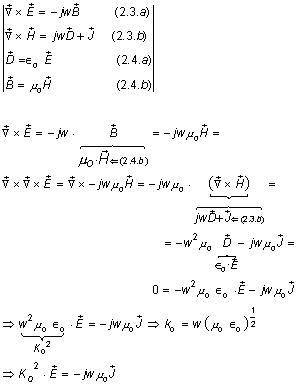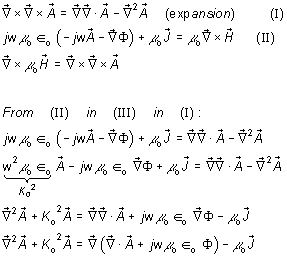![]() † (2.12)
† (2.12)

This is the
equation that must be solved to find the electric field directly in terms of
the specified current source
![]() †or,
†or,
i.e.,
![]()

MAXWELLíS EQUATIONS AND BOUNDARY CONDITIONS FOR ANTENNAS:
2.2 VECTOR
AND SCALAR POTENCIALS:
|
This is the
equation that must be solved to find the electric field directly in terms of
the specified current source
i.e.,
|
 |
In practice
a simpler equation to solve is obtained by introducing the vector potencial
![]() †and scalar potencial
†and scalar potencial
![]() .
.
![]()
![]()
![]() †(2.13)
†(2.13)
because
![]()
![]() † is called vector
potencial.
† is called vector
potencial.
(2.13) in
(2.3.a):
![]()
![]() (2.3.a)
(2.3.a)
![]()
![]()
![]()
Any
function with zero curl can be expressed as the gradient of a scalar function.
![]() †† (2.14)†
†† (2.14)†
![]()
![]()
(2.3.b)
![]()

††††

Using the expansion††††† ![]()
Besides
(2.14) assumption:††† ![]() †† (2.14)
†† (2.14)
itís also
assumed† that Eq.(2.3.b) will hold
![]()
|
|

|
(2.13)
![]()
![]() † fixed.
† fixed.
So far only
the curl of
![]() †is fixed by the
relation (2.13). Thus, we are still free to specify the divergence of
†is fixed by the
relation (2.13). Thus, we are still free to specify the divergence of
![]() . In order to simplify the equation for
. In order to simplify the equation for
![]() †we choose:
†we choose:
![]() † (2.15)
† (2.15)
†
![]() ††††† lorentz condition
††††† lorentz condition
Our
equation for
![]() †now becomes the
inhomogeneous Helmholtz equation:
†now becomes the
inhomogeneous Helmholtz equation:
![]() † (2.16)
† (2.16)
Using
(2.14) and (2.15) in Eq. (2.3.c)
(2.3.c)
![]() ††(Gaussí Law)
††(Gaussí Law)
![]()
![]()
![]()
![]()


![]() †
†
![]()
However, the change is not an independent
source term for time-vary ing fields, since itís is related to the current by
the continuity equation (2.3.e).
(2.3.e)
![]() †, and it is not
necessary to solve for the scalar potential
†, and it is not
necessary to solve for the scalar potential
![]() .
.
Using (2.15) (Lorentz condition) in (2.14)

![]()
 †(2.18)
†(2.18)
R.E.COLLIN-ANTENNAS-p.19
The simplification obtained by
introducing the vector potencial
![]() †may be appreciated by
considering the case of a z-directed current
source
†may be appreciated by
considering the case of a z-directed current
source
![]() †in which case
†in which case
![]() †and
†and
![]() †is a solution of the
scalar equation†
†is a solution of the
scalar equation†
![]()
The equation satisfied by the electric field is a vector equation even when the current has only a single component.